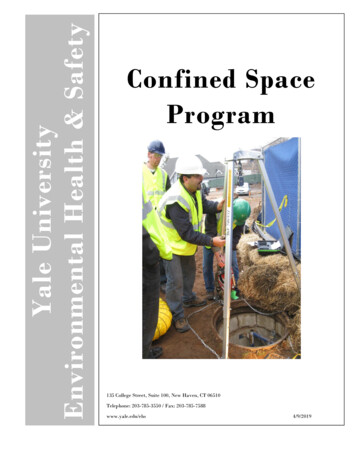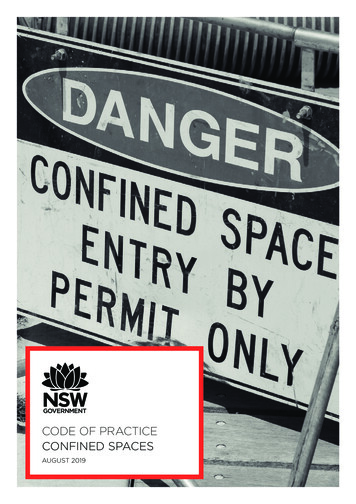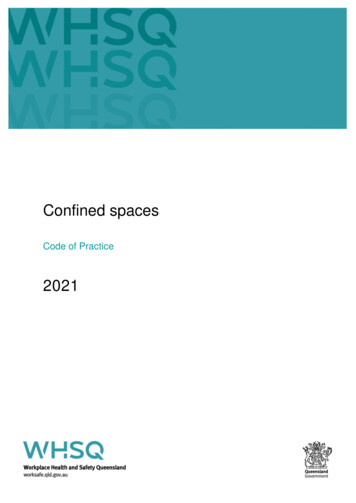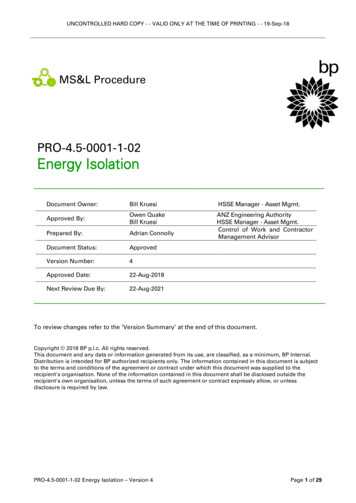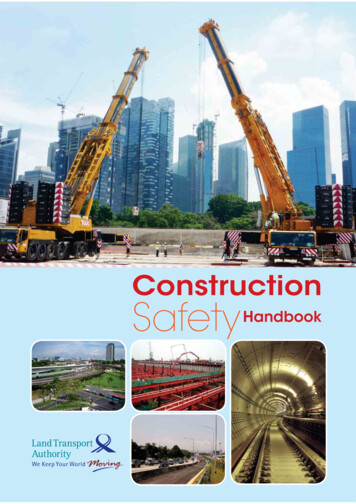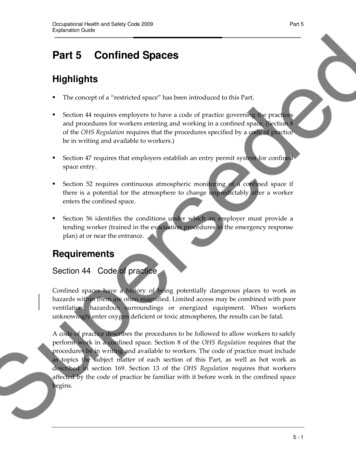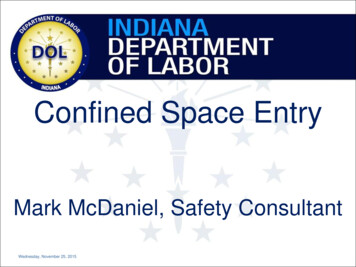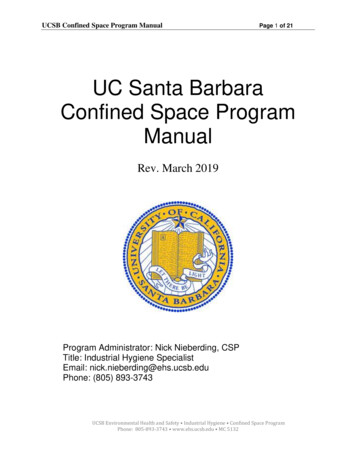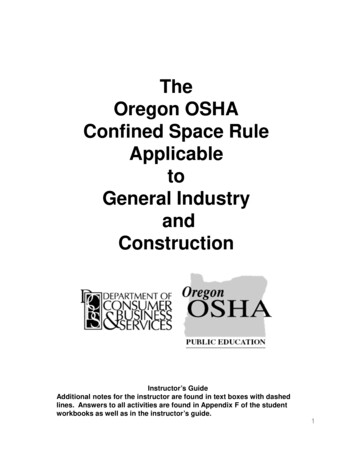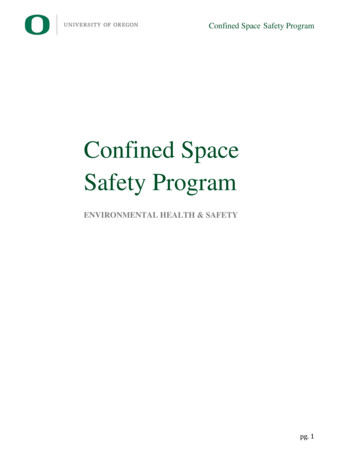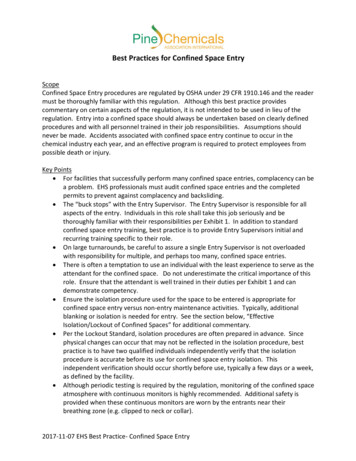
Transcription
Best Practices for Confined Space EntryScopeConfined Space Entry procedures are regulated by OSHA under 29 CFR 1910.146 and the readermust be thoroughly familiar with this regulation. Although this best practice providescommentary on certain aspects of the regulation, it is not intended to be used in lieu of theregulation. Entry into a confined space should always be undertaken based on clearly definedprocedures and with all personnel trained in their job responsibilities. Assumptions shouldnever be made. Accidents associated with confined space entry continue to occur in thechemical industry each year, and an effective program is required to protect employees frompossible death or injury.Key Points For facilities that successfully perform many confined space entries, complacency can bea problem. EHS professionals must audit confined space entries and the completedpermits to prevent against complacency and backsliding. The “buck stops” with the Entry Supervisor. The Entry Supervisor is responsible for allaspects of the entry. Individuals in this role shall take this job seriously and bethoroughly familiar with their responsibilities per Exhibit 1. In addition to standardconfined space entry training, best practice is to provide Entry Supervisors initial andrecurring training specific to their role. On large turnarounds, be careful to assure a single Entry Supervisor is not overloadedwith responsibility for multiple, and perhaps too many, confined space entries. There is often a temptation to use an individual with the least experience to serve as theattendant for the confined space. Do not underestimate the critical importance of thisrole. Ensure that the attendant is well trained in their duties per Exhibit 1 and candemonstrate competency. Ensure the isolation procedure used for the space to be entered is appropriate forconfined space entry versus non-entry maintenance activities. Typically, additionalblanking or isolation is needed for entry. See the section below, “EffectiveIsolation/Lockout of Confined Spaces” for additional commentary. Per the Lockout Standard, isolation procedures are often prepared in advance. Sincephysical changes can occur that may not be reflected in the isolation procedure, bestpractice is to have two qualified individuals independently verify that the isolationprocedure is accurate before its use for confined space entry isolation. Thisindependent verification should occur shortly before use, typically a few days or a week,as defined by the facility. Although periodic testing is required by the regulation, monitoring of the confined spaceatmosphere with continuous monitors is highly recommended. Additional safety isprovided when these continuous monitors are worn by the entrants near theirbreathing zone (e.g. clipped to neck or collar).2017-11-07 EHS Best Practice- Confined Space Entry
Pre-entry conferences are essential to a safe confined space entry. Entry Supervisorsshall ensure that pre-entry conferences occur not only at the beginning of the job, but atshift change, such as transitioning from day shift to night shift, and when personnel areadded or changed during the entry procedure.Many injuries and fatalities have occurred when unauthorized personnel enter aconfined space to attempt a rescue, and then they become another victim. Ensure yourtraining program strongly addresses the emergency procedures to rescue someone indistress in a confined space.If rescue personnel are summoned for another emergency, the attendant mustevacuate the confined space until rescue personnel are again available.Do not allow compressed gas cylinders (e.g. for hot work) to be located inside aconfined space. Also, ensure compressed gas hoses are removed at breaks and when nolonger needed.Performing hot work inside a confined space presents an array of unique hazards. Bestpractice is to issue the hot work permit with enhanced review and approvals. Forexample, if the hot work permit is normally issued by a single individual, consider havinga team of two or more supervisors review and approve the hot work permit. Clearly,the Entry Supervisor must be involved as well.What Constitutes “Entry” Into a Confined Space?OSHA defines “entry” as “the action by which a person passes through an opening into a PermitRequired Confined Space. Entry is considered to have occurred as soon as any part of theentrant's body breaks the plane of an opening into the space, regardless of whether there isintent to fully enter the space.” Letters of interpretation have clarified that incidentallybreaking the plane of a permit required confined space with one’s arm (only) for limited,specific tasks and without the intent of entering the space, or the risk of falling into the spaceand/or risk of exposure to any safety and health hazard within the space is not consideredentry.Permit-Required Confined Space Entry ProgramA documented Permit-Required Confined Space Entry Program is required if employees aregoing to enter confined spaces. This is typically in the form of a documented safe work practicespecific to this subject. OSHA has many requirements descried in 29 CFR 1910.146(d). Theregulation is quite comprehensive and if strictly followed, the facility will have a very goodconfined space entry program. Key points are: In addition to making sure your safe work practice/program meets the requiredelements, make sure the program is a living and useful document for the workforce.The required annual review of the program with employees participating is critical tosuccess. Have clear roles and responsibilities defined. Ensure contractors follow your program requirements. Ensure your program has integrated the best practices described in this document.2017-11-07 EHS Best Practice- Confined Space Entry
Entry PermitThe entry permit requirements are described in 29 CFR 1910.146(f). Key points are: Audit completed permits to ensure that they were completely and correctly filled out.Due to the size of the permit, there are many opportunities to make errors. Ensure contractors use your confined space entry permit. If they have a policy of usingtheir own permit, require the use of both confined space entry permits. For contractors entering a confined space, it is permissible for a contractor supervisor tobe the Entry Supervisor if properly trained. However, best practice is that the entrypermit to be opened by a facility Entry Supervisor and for a facility Entry Supervisor toclose the entry permit at the conclusion of the entry.Effective Isolation/Lockout of a Confined SpaceIsolation/lockout for entering confined spaces involves additional measures compared toisolation for non-entry work. Consider the following.If an isolation procedure for the purpose of confined space entry was prepared well in advanceof the planned entry, best practice is to have two qualified individuals independently verify thecorrectness of the isolation procedure a few days prior to its use. This practice would catch anychanges to the confined space, such as additional pipelines entering/exiting the confined spacenot updated by a Management of Change procedure.Isolation of pipelines connected to the confined space need to have measures beyond simplyclosing and locking a valve. Best practice is to: Install a blind/blank flange on the end of a disconnected line, or Install a “slip blank,” suitable for pipeline pressure, in between a pair of flanges in theline, or Provide an “air gap” such as removing a short section of pipeline, or If your facility allows it, use a “double block and bleed” isolation. (See Hazardous EnergyIsolation for diagrams of double block and bleed isolations.)Rescue Services and What Constitutes Timely Rescue?What is considered timely rescue? The regulation in 1910.146(k)(1)(i) only states “timelyrescue,” but they did provide a note to indicate that the response time will vary according tothe specific hazards involved for each entry. Also note that the Respiratory Protection standardrequires that employers provide a standby person or persons capable of immediate action torescue employee(s) wearing respiratory protection while in work areas defined as IDLH(immediately dangerous to life and health) atmospheres.An employer who designates rescue and emergency services shall meet the requirementsdescribed in 29 CFR 1910.146(k). Rescue personnel can be part of an employer’s work force, bea contracted service, or the local municipal emergency responder. The guidance provided by2017-11-07 EHS Best Practice- Confined Space Entry
the regulation is very good, but the following advice is offered: The evaluation and selection of a third-party rescue service requires considerable effortto do it right. Don’t rush through this process. Best practice is to have a rescue plan developed in advance for each specific confinedspace to be entered.TrainingThe regulation states that the employer is responsible for providing initial training and recurringtraining as changes or deviations occur to the program. Best practice for recurring training isannual. Also, best practice is to have additional, more detailed, training for Entry Supervisorsto ensure that they clearly understand their duties. Note that training shall be documented andbe available for inspection by employees, their authorized representatives and regulators.Disclaimer: The statements contained in this publication are suggestions to enhance performance of certain activities.There is no warranty or guarantee that following these suggestions will prevent each and every incidence of personalinjury or property damage. Neither Pine Chemicals Association International nor any of its agents, officers, employees,consultants or contractors, warrants the accuracy, reliability, completeness or timeliness of any information publishedhere and shall not be liable for any losses caused by such reliance on the accuracy, reliability, completeness or timelinessof this information, including, but not limited to, incidental or consequential damages. This publication is provided withoutwarranty of any kind, either express or implied, including, but not limited to, an implied warranty of merchantability, fitnessfor a particular purpose, compliance or non-infringement. The recipient of this information is responsible for compliancewith all applicable restrictions, regulations, statutes or other standards or conditions.2017-11-07 EHS Best Practice- Confined Space Entry
Exhibit 1Roles and Responsibilities as Defined in the Confined Space Entry RegulationDuties of Entry SupervisorsThe employer shall ensure that each entry supervisor: Knows the hazards that may be faced during entry, including information on the mode,signs or symptoms, and consequences of the exposure; Verifies, by checking that the appropriate entries have been made on the permit, that alltests specified by the permit have been conducted and that all procedures andequipment specified by the permit are in place before endorsing the permit andallowing entry to begin; Terminates the entry and cancels the permit; Verifies that rescue services are available and that the means for summoning them areoperable; Removes unauthorized individuals who enter or who attempt to enter the permit spaceduring entry operations; and Determines, whenever responsibility for a permit space entry operation is transferredand at intervals dictated by the hazards and operations performed within the space,that entry operations remain consistent with terms of the entry permit and thatacceptable entry conditions are maintained.Duties of Authorized EntrantsThe employer shall ensure that all authorized entrants: Know the hazards that may be faced during entry, including information on the mode,signs or symptoms, and consequences of the exposure; Properly use equipment, e.g. communications, ventilation, PPE, continuous monitors (ifprovided), etc.; Communicate with the attendant as necessary to enable the attendant to monitorentrant status and to enable the attendant to alert entrants of the need to evacuate thespace; Alert the attendant whenever:o The entrant recognizes any warning sign or symptom of exposure to a dangeroussituation, oro The entrant detects a prohibited condition; and Exit from the permit space as quickly as possible whenever:o An order to evacuate is given by the attendant or the entry supervisor,o The entrant recognizes any warning sign or symptom of exposure to adangerous situation,o The entrant detects a prohibited condition, oro An evacuation alarm is activated.2017-11-07 EHS Best Practice- Confined Space Entry
Duties of AttendantsThe employer shall ensure that each attendant: Knows the hazards that may be faced during entry, including information on the mode,signs or symptoms, and consequences of the exposure; Is aware of possible behavioral effects of hazard exposure in authorized entrants; Continuously maintains an accurate count of authorized entrants in the permit space; Remains outside the permit space during entry operations until relieved by anotherattendant; NOTE: When the employer's permit entry program allows attendant entryfor rescue, attendants may enter a permit space to attempt a rescue if they have beentrained and equipped for rescue operations and if they have been relieved. Communicates with authorized entrants as necessary to monitor entrant status and toalert entrants of the need to evacuate the space; Monitors activities inside and outside the space to determine if it is safe for entrants toremain in the space and orders the authorized entrants to evacuate the permit spaceimmediately under any of the following conditions;o If the attendant detects a prohibited condition;o If the attendant detects the behavioral effects of hazard exposure in anauthorized entrant;o If the attendant detects a situation outside the space that could endanger theauthorized entrants; oro If the attendant cannot effectively and safely perform all the duties required. Summon rescue and other emergency services as soon as the attendant determines thatauthorized entrants may need assistance to escape from permit space hazards; Takes the following actions when unauthorized persons approach or enter a permitspace while entry is underway:o Warn the unauthorized persons that they must stay away from the permit space;o Advise the unauthorized persons that they must exit immediately if they haveentered the permit space; ando Inform the authorized entrants and the entry supervisor if unauthorized personshave entered the permit space; Performs non-entry rescues as specified by the employer's rescue procedure; and Performs no duties that might interfere with the attendant's primary duty to monitorand protect the authorized entrant.Disclaimer: The statements contained in this publication are suggestions to enhance performance of certain activities.There is no warranty or guarantee that following these suggestions will prevent each and every incidence of personalinjury or property damage. Neither Pine Chemicals Association International nor any of its agents, officers, employees,consultants or contractors, warrants the accuracy, reliability, completeness or timeliness of any information publishedhere and shall not be liable for any losses caused by such reliance on the accuracy, reliability, completeness or timelinessof this information, including, but not limited to, incidental or consequential damages. This publication is provided withoutwarranty of any kind, either express or implied, including, but not limited to, an implied warranty of merchantability, fitnessfor a particular purpose, compliance or non-infringement. The recipient of this information is responsible for compliancewith all applicable restrictions, regulations, statutes or other standards or conditions.2017-11-07 EHS Best Practice- Confined Space Entry
2017-11-07 EHS Best Practice- Confined Space Entry Best Practices for Confined Space Entry Scope Confined Space Entry procedures are regulated by OSHA under 29 CFR 1910.146 and the reader must be thoroughly familiar with this regulation. Although this best practice provides commentary on certain aspects of the regulation, it is not intended to be used in lieu of the regulation. Entry into a .
